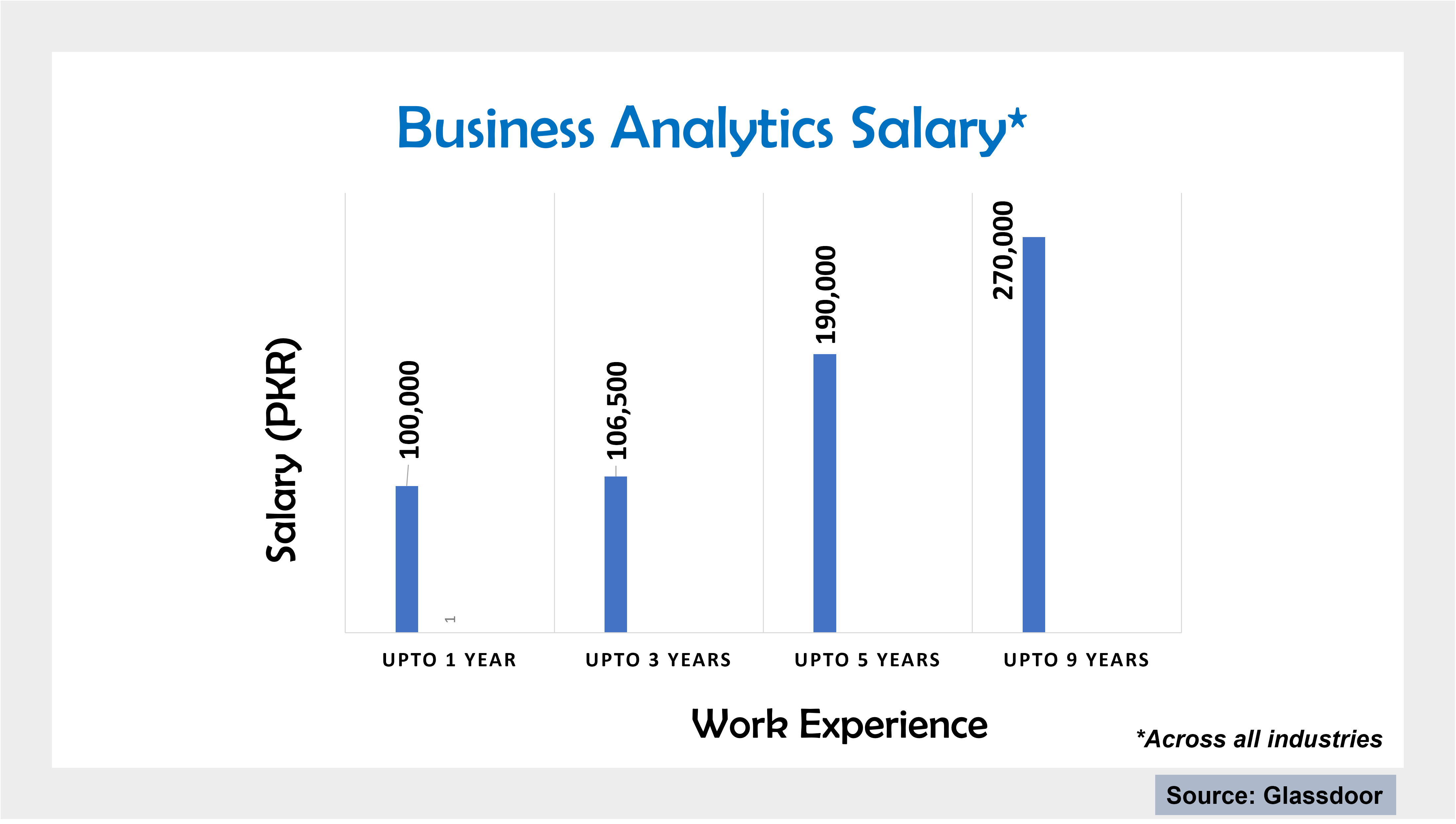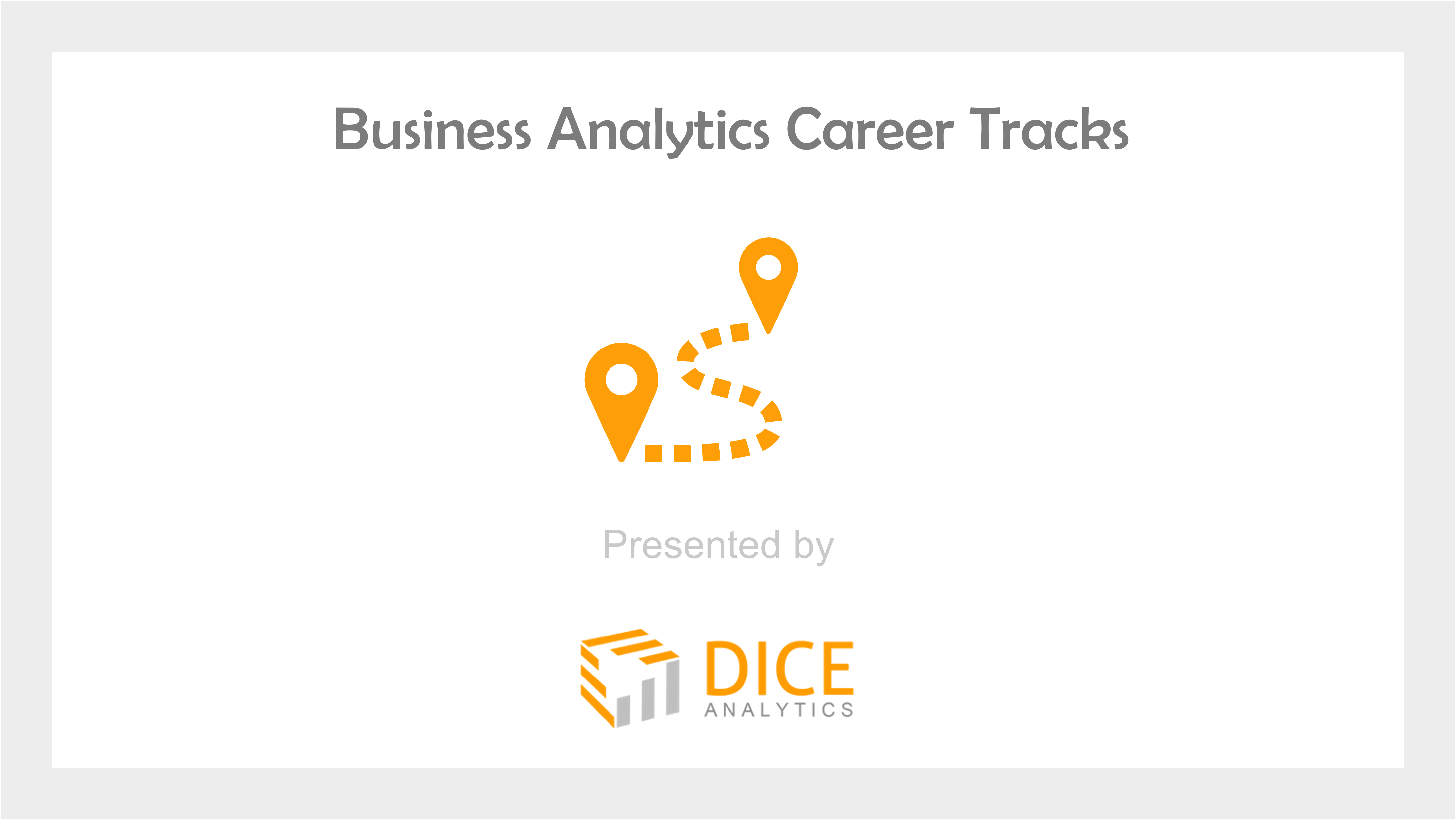Data Analytics is a panacea that holds massive economic opportunities for businesses in Pakistan. With this very reason, as well as due to the growing concerns on economic stability, there’s a heated debate on using technology to enable accelerated financial growth in the country.
This article stems from the growing demand of digital tech professionals, highlighting specifically the business analytics domain and its selection as a career.
Fortunately, this is the bright chance to start your career in this data-driven field.
Table of Contents
How companies benefit from Business Analytics?
Business Analyst Salary in Pakistan
What is Business Analytics?
Business Analytics, a sub-domain of Data Analytics, specifically deals with data in business organizations. The end goal is to ‘effectively’ drive business decision making using data.
BA is not a single discipline. Rather it’s a multitude of disciplines and technologies for collecting, transforming, storing, and analyzing business data, as it arrives from multiple heterogeneous data sources.
But why opt for Business Analytics?
Trends and patterns in historical data can offer businesses great insights into how their customers interact with them and how effective their marketing practices have been.
This helps them streamline processes as per market demands.
For this information to divulge, a business analyst uses statistical methods, data analysis, and mathematics knowledge to accomplish its data goals.
Following is how Tech Target defines Business Analytics (BA):
“Business analytics (BA) is a set of disciplines and technologies for solving business problems using data analysis, statistical models and other quantitative methods. It involves an iterative, methodical exploration of an organization’s data, with an emphasis on statistical analysis, to drive decision-making.”
Note: In above definition, the term iterative data exploration means reviewing the BA process to improve over time.
How companies benefit from Business Analytics?
It would not be an overstatement to say that business analytics is benefiting organizations in virtually endless ways.
By this, it means that BA adapts to any kind of business and could be used in innovative ways to capture any data related to solve any business problem.
While companies continue to adopt business analytics solutions for data-driven decision making (read the bright prospects here), there’s some sound research that quantifies the success of business analytics for organizations.
As an example, take the 2020 survey by Microstrategy (a global leader in BI products) asking companies, for the second consecutive time, about: benefits from the data analytics initiatives, and if the data-driven culture was moving forward.
As per the survey, organizations achieved the following benefits:
- Efficiency and productivity improved in majority (64%) organizations,
- Decision making improved and became more efficient in more than half (56%) of organizations
- Financial performance improved in over 51% of organizations
- Nearly half (46%) could identify and create new product and service revenue
- Customer acquisition and retention improved in as much as 46% of organizations
- 44% could deliver an improved customer experience
- 43% felt they attained competitive advantage in the market
And are any of these organizations are planning business analytics initiatives in future too?
Talking about organizations who are moving forward with their business analytics initiatives, the survey identified blooming trends.
More than half (59%) of organizations said they’re now advancing toward using advanced and predictive analytics (a rise of 7% from the previous year).
The survey also found that this percentage is shifting tremendously based on revenue. The more revenue, the better confidence.
This includes 65% of the companies with revenue between $100m to $500m in revenue confirm their use of advanced and predictive analytics, while just 46% thereof under $10m in revenue can say the same.
Demand is more than Supply!
Big data demand is sky-rocketing right now, and will keep on accelerating till 2027 for sure. The market for big data is expected to reach $450 billion globally with nearly all companies determined to operate digitally.
This tremendous demand for a data-driven ecosystem puts pressure on the supply of analytical savvy individuals who are the prospects of big data future. In a 2017 report by burning glass technologies, it was identified that data science jobs will reach over 2.7 million, by the end of 2020, alone in the US while the supply will reach 2.8 million for the same time frame.
Thinking of the above statistics, though it seems the demand-supply gap is not significant, however, the reality follows the opposite.
For example, it was highlighted in the same report that the US employers faced difficulties in filling data analytics job roles with senior positions taking more time to fill up.
Why supply is limited?
One reason why global experts fear the limited supply of data scientists is due to the diverse and domain specific skills it requires.
As an example, the report cites the case of a marketing analyst manager, who requires advanced analytical techniques and deep marketing know-how to qualify for the position. Both of the domains require you to put some time in learning, discouraging students to go for more easy career options.
All of these factors create a wide demand-supply gap, creating an ever increasing demand for business analysts accompanied with higher salary packages to attract tech savvys.
Career Options in Business Analytics
Business analytics serves many industries and over a vast number of roles making it easy for individuals to opt for the field of their interest.
Examples of a BA job role includes….
For example, a business analyst in the product development department, would design a data funnel (aka product or event funnel) to identify customer choke points. These are the problem points where your customers are stuck and spend unnecessary time to figure out the process.
Or the task of a business analyst in the marketing department would be to utilize predictive analytics to cluster out customer churn groups and identify reasons for customer churn.
Following is a list of most common job titles under Business Analytics job roles. These are elicited from Indeed, Glassdoor, Rozee, Google Jobs, and Linked In in Pakistan.
You might want to read about the job role of a business analyst in the Telecom Industry.
Business Analyst Salary in Pakistan

In Pakistan, business analytics job opportunities are increasing compared to the past and companies are willing to pay more to retain data-driven capable employees.
We dug out the salary dirt across various platforms and came to find a fair estimate on Glassdoor. While Glassdoor also estimates pay from surveying its users across the domain, in reality it depends on a company as to how much they are willing to pay you.
Hopefully this salary guide will bring awareness to you as to how much you deserve as a business analyst.
There are three categories of pay ranges in the Business Analytics domain based on work experience.
- For entry level business analysts with 1 year of experience, Glassdoor estimates the most probable median pay of PKR 100,000 (lac) per month with basic pay 50k and additional pay as 50k. Additional pay could include cash bonus, commission, tips, and profit sharing.
- Reaching 3 years of experience, the pay for associate business analyst is likely to rise between a median of Rs 106,500 to a max of Rs 190,000. The median basic pay is Rs 70,000 and that of additional pay is Rs 36,000.
- For individuals with 5 years of experience, the pay could jump to a median of Rs 190,000 to a maximum of Rs 513,000. Median basic pay is Rs 90,000 and additional pay is Rs 100,000.
- According to Glassdoor, senior business analysts with experience of up to 9 years can enjoy a pay of Rs 270,000. Basic pay range (not median) is between Rs 107,000 to Rs 195,000 and that of additional pay is Rs 75,000.
Note: The following estimates are calculated over all industries. When you move to a specific industry, the pay may rise.
Skills needed to be a Business Analyst
Business analyst job qualification is a set of skills (basic to advance) that are compulsory to kick-start a career and sustain it down the road.
The top skills for business analysts compiled here will help newbies achieve a high paying job role.
Good news is that people from all professional backgrounds can learn these skills even if they have zero experience in the technical domain.
The reason is that at the basic level, the knowledge and tools have a smooth learning curve and allows individuals to quickly grasp them.
No code/low code tools are prevailing…
Fortunately enough, even at the advanced level, the analytical capabilities are now available in easy to use (no code/low code tools) that are increasingly adopted by organizations.
The basic skills you need to have in your profile when you apply for business analytics jobs are as follows.
- Microsoft Excel
Excel is termed as one of the top skills for business analysts other than SQL and PowerBI. Excel empowers companies to enable data analysis by offering powerful tools for cleaning, transforming and analyzing the data.
You might also want to view Top 15 most powerful Excel Functions for Data Analysis
- SQL
SQL is by far the most widely accepted programming language in the data analytics industry and is a must have for a business analyst.
The 40 year old language is well documented and is very easy to learn.
You might also want to view SQL and Database management, What You Need to Know
- Statistics for Data Analysis
When we talk about data, statistics is that branch of mathematics that helps us in collection, description, and analysis of the data.
The knowledge of statistics is considered critical for any data analytics domain and is easy to learn when divided over a time frame.
- Business Forecasting
Since business analytics deals with business data, business forecasting is another skill that helps an individual get an edge over others when applying for a job role.
In business forecasting, tactics are applied to take improved business decisions using single variate and multivariate regression.
- Microsoft Power BI
Power BI is a free business intelligence tool by Microsoft and is successfully leading the BI tools across the data analytics landscape. It’s used to collect, and process data and provides state-of-the-art visualization features to convert data into actionable insights.
Microsoft’s certification for Power BI is highly recognized in the corporate sector and helps Business Analysts to land on lucrative job opportunities.
- Tableau
The second most powerful BI tool is Tableau by Salesforce. It offers closely similar features like Power BI and there’s a high demand of Tableau certified business analysts in the industry.
Advanced skills include:
- Python
Python is a powerful programming language that enables advanced, scalable, automated, and efficient data science functions. These functions include, data wrangling, data visualization, and machine learning tasks.
Python is #1 skill when it comes to advanced business analytics.
- Machine learning (Predictive, and Prescriptive Analytics)
It employs the use of statistics and programming to make predictions based on historical data. Python is the most common tool to do so.
Predictive and prescriptive analytics are two methodologies of machine learning.
- Deep Learning (Neural Networks)
It’s an advanced level of machine learning and uses programming to build neural networks that can powerfully predict outcomes without needing any labeled training data.
Python is the most common tool for constructing neural networks.
- No-code analytics using KNIME
KNIME is an open-source data analytics platform that offers complex data science functionalities in a drag-and-drop facility.
There’s no coding required offering professionals from any technical background to build and utilize data science applications.
Since its inception in 2006, KNIME has become highly popular and is used in 60 countries.
Business Analytics Career Paths

At Dice Analytics, Pakistan’s leading analytics experts consistently emphasize on the right career paths for data analytics job roles.
Here we present two career tracks for newbies who wish to opt a high paying business analytics job role.
Career Track 1: Data Analyst
Anyone who wants to build a career in marketing and love to work with marketing people should opt for a Data Analyst career path. The equivalent terms used for a data analyst role are BI developer and BI engineer.
Course 1: Data Warehouse and Business Intelligence
Data engineering is one of the basic requirements for a business analytics job role.
It helps individuals understand the collection and storage of data in an organization.
The course covers concepts such as:
- Hands-on SQL (standard and Teradata specific)
- Using SQL to build ETL pipelines (data collection, transformation, and normalization)
- SDM Layer and Dimensional modeling
- Power BI
- Tableau
With flexible pricing and hybrid learning environment (online/on-site) the course is distributed in a 2-months time frame.
Find more details on the course here!.
Anyone is encouraged to apply for a free consultancy in ‘Reserve Seat‘.
Course 2: Business Analytics
Now, we have come to the point where your business analytics journey can take-off.
The next step encourages you to learn statistical analysis methods, combined with marketing concepts.
You will learn:
- MS Excel Hands-on
- Commercial Avenues of Data Analytics
- SQL (standard and Postgres specific)
- Python for statistical analysis
- Power BI for marketing dataset visualization
With flexible pricing and hybrid learning environment (online/on-site) the course is distributed in a 2-months time frame.
Find more details on the course here!.
Anyone is encouraged to apply for a free consultancy in ‘Reserve Seat‘.
Course 3: Marketing 101
This course will add an extra level to your BA profile. With free courses available online, learn marketing concepts and get a grip on building strategy to sell.
The contents you ought to find are:
What’s marketing, 4Ps of Marketing, Customer Churn Analysis, Fraud Detection, RFM Analysis, Google Analytics and Channel Analysis, and Customer value management.
This course is offered by Google Garage, Datacamp, and Udemy.
Career Track 2: Data Scientist
As you may already have an idea, Data Scientist job role is hyped globally and generously rewards individuals who have a good grasp of it.
The journey of a good data scientist starts with learning data warehouse/database concepts.
Remember, jumping directly to machine learning is not suggested by experts. Read more at How to become a data scientist in Pakistan.
Course 1: Data Warehouse and Business Intelligence
Same as outlined in the previous section.
Course 2: Data Science and Machine Learning
This covers basic to advanced machine learning concepts:
- Python an exploratory data analysis (EDA)
- Feature engineering
- Probability and Regression
- Predictive Models Accuracy
- Unsupervised Learning/Associate Rules
- PCA and model Deployment
- Industry Project and Presentation
With flexible pricing and hybrid learning environment (online/on-site) the course is distributed in a 2-months time frame.
Find more details on the course here!.
Anyone is encouraged to apply for a free consultancy in ‘Reserve Seat‘.
New: Dice Analytics is an official partner with KNIME. We offer an 8-week course on no code data science here.
Course 3: Business Analytics
Same as outlined in the previous section.
Further Readings
Breaking 5 myths in Data Science: By an Expert Data Scientist
How Big Data is helping Telecom Industry
There’s more to Data Science than Technology: Role of Human Talent and Diversity




